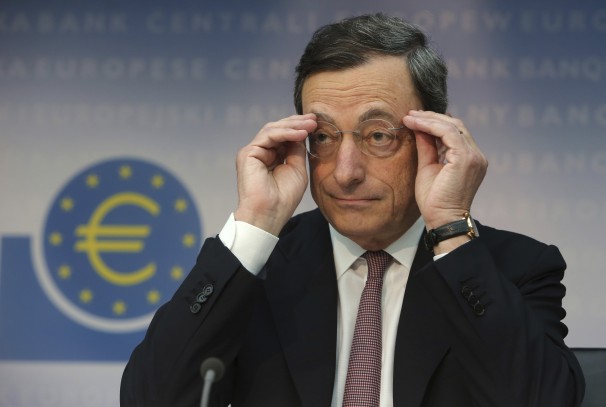
Now may not be the time to buy bonds
June 7, 2014
Less than zero: Europe introduces negative interest rates to save its economy
June 7, 2014Roberto Keller-Perez
Miguel Seabra will take over as president of Science Europe in September.
Last month, Miguel Seabra, president of the Portuguese Foundation for Science and Technology (FCT), was elected as the next president of Science Europe, a Brussels-based organization of 52 research agencies from 27 European countries, both inside and outside of the European Union.
Already a member of Science Europes’s governing board, Seabra will take the reins in September from Paul Boyle, the chief executive of the UK Economic and Social Research Council and soon to become the president of the University of Leicester, UK.
At the third annual meeting of the Global Research Council, a gathering of funding-agency heads in Beijing in May, Seabra spoke to Nature about smart spending and the pluses and minuses of integrating science across the continent.
- Lunar rocks’ isotopes confirm theory of Moon origin
- EU cuts clinical-trial red tape
- Taipei frogs use storm drains to boost mating calls
For a group that represents organizations with a combined research budget of around €30 billion (US$41 billion) a year, Science Europe is still relatively unknown. Should it have more clout?
Yes and no. It’s a young organization, founded in 2011, and although our members control a significant proportion of the national research budgets, we are somewhat dependent on the national structures above us. But I think that we have established ourselves as an important voice and managed to succeed in being heard. We’ve been proactive, for example, as the third voice in [discussions about] fostering the European Research Area (ERA) project, along with national governments and the European Commission.
The ERA’s mission is to create a single market for research in Europe to ensure the circulation of researchers, knowledge, ideas and technology. How important it is that European countries meld their research efforts into some sort of single effort?
The question is: how deep are we going into some kind of integration or homogenization of science in Europe? The general view at Science Europe is that there is an issue of balance in Europe between competition, cooperation, coordination and researcher circulation. Also, that diversity of system is an asset and not a liability. I don’t think we are of the view that we should construct some sort kind of federalized, homogenized, centralized European research system.
Would national research funders ever agree to opening up funding to all European researchers?
I don’t think that’s on the horizon at the moment. What’s being discussed is mobility, and issues like money following the researcher.
One of the issues being discussed at the Global Research Council is open access to research publications. Do funders have a responsibility to push through this kind of change, to alter the culture of science?
There is no question that open access to publications is a very important issue for the advancement of science and for the progress of humanity. At Science Europe, we support flexibility in the approach, such as allowing for both a gold and green model. We see that there needs to be flexibility as some systems might be more applicable to some disciplines, or some countries might view these issues in different ways. But we also think there are non-trivial issues that need to be addressed. We’re planning to have our governing board meet with publishers, so that we also make a strong effort to understand the other side and not be in a position of arrogance.
Does the same apply to making data publicly available?
Theoretically, making data open is a great idea. In practical terms, it might be difficult to implement. In the same way, open access to publications seems like such an easy issue, but there are issues around the quality of repositories in green models, maintaining these archives — they are all costly enterprises that nobody seems to be particularly willing to pay for.
In Portugal, the proportion of gross domestic product spent on research and development fell between 2010 and 2012 owing to the global financial crisis, after having risen steadily between 2004 and 2009. How is the country’s research system coping with austerity?
There is no question that the Portuguese system has grown in quantity in a dramatic way in the last 10 to 20 years. The challenge now is to continue to grow in quality, because we’re still catching up. At FCT we’re establishing new funding instruments — for example a five-year contract called ‘investigator FCT’ for anyone who wants to be a principal investigator in Portugal — that will make us more similar to what is available in high-performing countries in northern and central Europe. And we’re working towards funding centres of excellence in Portugal. We’ve also established, again catching up with the European trend, a national road map for infrastructures.
So Portugal is spending a reduced budget in a smarter way?
Since 2011, we have been able to pay out the same amount of money or slightly more because of very hard work to better use the one-third of the FCT budget that comes from European structural funds for science.
In March, the founders of the Portuguese National Association of Researchers in Science and Technology, wrote in a letter to Nature that evaluation procedures for recruitment, career progression and funding allocation need to be reformed so that they are based solely on merit. Do you recognize this as a problem?
I think this opinion is a reaction to change. At FCT we have introduced stricter guidelines in terms of internationally accepted best practice in peer review. And I think that the reaction is also because, in the context of the crisis and the research community growing exponentially every year, the grant application success rates have gone down to below 20%. That has created a new level of competitiveness that we are not used to and people are blaming due process and unfair reviews. I’m confident that we’re doing everything by the book. We’re also changing those books every year to move closer to the international best practice.




